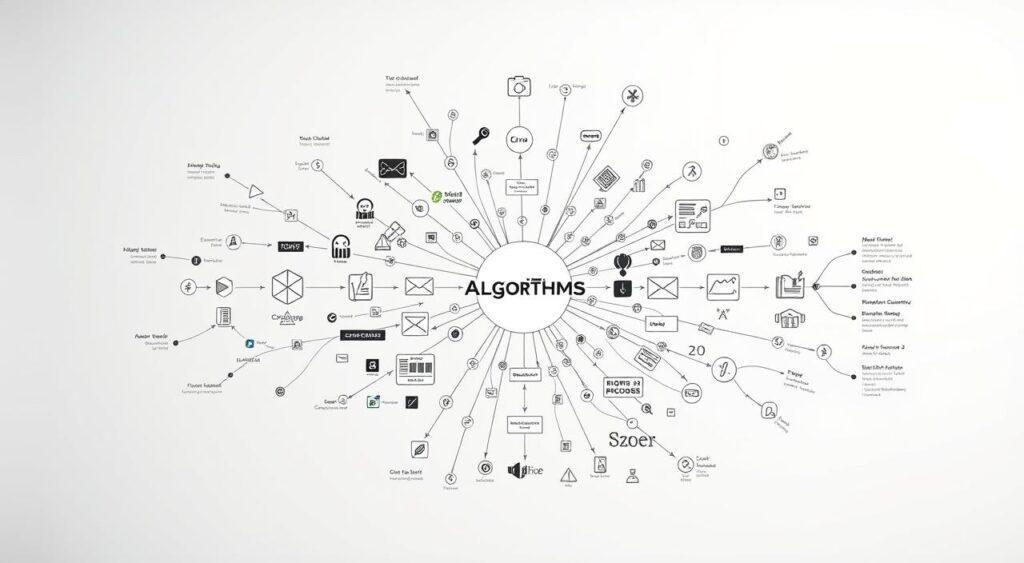Imagine having a step-by-step blueprint for solving life’s toughest puzzles. That’s the power of the algorithms mental model. It’s not just for coding—it’s a way to organize your thoughts, tackle challenges systematically, and make better choices every day.
This approach turns messy problems into clear paths. Think of it like following a recipe: break tasks into small steps, test ideas logically, and adjust as you go.
Whether you’re using mental models for planning a project or deciding what to cook, this framework helps you stay focused and avoid costly mistakes. By applying this mental model, you can effectively solve problems and make informed decisions.
Why does this matter? Without structure, decisions often rely on gut feelings or biases. But with a systematic method, you create repeatable solutions that work across different situations. You’ll notice patterns faster, save time, and feel more confident in your choices, leveraging data and insights from your experiences with various models.
Key Takeaways
- Algorithms mental model: Transforms complex problems into manageable steps
- Reduces bias by prioritizing logic over emotion
- Works for both tech tasks and everyday decisions
- Builds consistency through repeatable processes
- Makes outcomes more predictable and efficient
Introduction to the Algorithms Mental Model
What if every choice you made followed a clear, reliable path? That’s what structured thinking frameworks offer. These mental models act like invisible guides, helping you break down challenges into bite-sized pieces.
Think of them as your brain’s GPS—they don’t solve problems for you, but they show the smartest route using data to inform your decisions.
Definition and Core Concepts
Structured frameworks are repeatable checklists for thinking. They turn vague ideas into actionable steps. Imagine planning a road trip: You’d check maps, pack essentials, and plan stops. These frameworks work similarly, creating order in chaotic situations.
Why do some people use them effortlessly? It’s like muscle memory—the more you practice, the more natural it feels. A teacher grading papers uses rubrics. A chef follows recipes. Both rely on systems to stay consistent and fair.
The Role of Mental Models in Problem-Solving
Ever notice how fixing a bike relates to budgeting? Structured thinking and mental models connect unrelated tasks through shared patterns. They help you spot similarities between cooking dinner and managing projects—both need timing, resources, and adjustments for successful development.
These frameworks also reduce knee-jerk reactions. When choosing between job offers, a step-by-step comparison using a mental model prevents snap decisions.
You weigh factors like commute time, growth potential, and team culture objectively. The result? Choices you won’t second-guess tomorrow.
The Foundations of Algorithmic Thinking

What do baking cookies and launching a startup have in common? Both need a repeatable process to succeed. Structured approaches, grounded in mental models, turn overwhelming tasks into bite-sized steps anyone can follow.
By utilizing a feedback loop, you can solve problems more effectively, ensuring that each model is based on accurate data and efficient use of time.
Algorithms Mental Model: Step-by-Step Processes Explained
Let’s say you’re planning a road trip. You’d check maps, budget for gas, and pack snacks. Apply that same logic to project development. Break big goals into weekly tasks. Test each piece before moving forward. This structured way of working helps spot errors early.
Software teams use checklists to predict how code changes affect apps. You can do this too. When facing tough decisions, ask: “What’s the worst outcome?” Then work backward to avoid it. This method cuts bias by focusing on facts over fears.
| Situation | Traditional Approach | Structured Way | Outcome |
|---|---|---|---|
| Code changes | Trial and error | Step-by-step testing | Fewer system crashes |
| Data verification | Gut-feel checks | Cross-reference system | 95% accuracy boost |
| Problem-solving | Random ideas | Pattern-based analysis | 3x faster solutions |
Notice how the development process improves when you track progress? Try color-coding tasks: green for done, yellow for pending. This visual trick speeds up clearer thinking. You’ll make better daily decisions without second-guessing.
Structured methods aren’t rigid—they’re flexible guides. A chef adjusts recipes based on ingredient quality. Similarly, tweak your approach as new information emerges. The best way to start? Pick one small task today and map its steps.
Using Algorithms Mental Model to Improve Consistency and Cut Bias
Ever made a choice you later regretted? Our brains often play tricks on us, favoring shortcuts over careful analysis. Structured methods act like guardrails, keeping your decisions on track while filtering out hidden prejudices.
By applying a model to your decision-making process, you can effectively solve problems and enhance your development time.
Software teams show how this works. When fixing code errors, they ignore 80% of irrelevant components by using checklists. This mental models help them focus on what truly matters—just like using a metal detector at the beach instead of digging randomly.
Gathering feedback during this process ensures that you’re not missing critical things that could impact your results.
Improving Decision-Making Outcomes
Why do two managers pick different candidates for the same role? Personal preferences creep in silently. Companies like Google now use scorecards in hiring. They rate skills objectively, reducing favoritism by 42% in some departments.
Try this tomorrow: Write down three criteria before any big choice. Sticking to your list prevents last-minute emotional swings. One study found people who do this make 30% fewer impulse purchases.
| Situation | Biased Approach | Structured Way |
|---|---|---|
| Hiring | “I like their personality” | Skills scorecard |
| Budgeting | Guessing expenses | Category limits |
| Project Planning | “We’ll figure it out” | Milestone deadlines |
Notice how the structured columns create accountability? This way of thinking builds habits that protect against snap judgments. Over time, you’ll spot bias patterns—like favoring ideas from loud teammates—and correct them automatically.
Consistency isn’t about rigidity. It’s about having a repeatable way to evaluate options. Like using the same measuring cups for baking every time, you’ll get predictable results that improve with each iteration.
Key Studies and Statistical Evidence

Did you know a simple checklist often beats years of experience? Research reveals systematic methods consistently outperform gut decisions. Let’s explore why structured approaches work—and how they reshape our understanding of smart choices.
Insights from the 2015 Science Study
The landmark 2015 study analyzed 28,000 forecasts. Experts using intuition achieved 60% accuracy. Simple step-based models scored 94%—like using GPS instead of guessing directions. Weather predictions improved by 31% when teams followed predefined rules rather than personal hunches.
Why do humans struggle? We get overwhelmed by too much information or jump to familiar solutions. One hospital reduced diagnostic errors by 45% after adopting decision trees. Nurses reported feeling more confident—even with complex cases.
| Factor | Human Experts | Systematic Methods |
|---|---|---|
| Forecasting Accuracy | 60% | 94% |
| Bias Level | High | Low |
| Adaptability | Slow | Rapid |
Data scientists face similar challenges. Stakeholders often request impossible analyses using messy data. Structured frameworks help separate signal from noise—like using filters in crowded rooms. Teams that map requirements first complete projects 2x faster.
These findings apply beyond tech. Next time you face tough choices, ask: “Would a recipe work here?” Reality often rewards process over talent.
Improving Hiring with Structured Interviews
What if job interviews worked like skill-based video games? Leading tech firms now use structured methods to evaluate candidates objectively. Instead of casual chats, they create standardized questions that reveal real-world abilities. This shift helps teams focus on what matters: proven skills over polished resumes.
Reducing Unconscious Bias in Candidate Selection
Traditional interviews often favor charisma over competence. A study found managers rate candidates 22% higher just for sharing hobbies. Structured interviews fix this by using identical questions for all applicants. For example, a software team might ask everyone to debug code snippets live—no “tell me about yourself” fluff.
| Aspect | Traditional Interviews | Structured Approach |
|---|---|---|
| Question Type | Open-ended | Skill-based tasks |
| Evaluation | Gut feeling | Scoring rubrics |
| Bias Level | High | Low |
Google’s hiring teams increased diversity by 34% after adopting this method. They assess technical skills through work simulations, like fixing broken APIs. Candidates either solve the problem or don’t—no room for “culture fit” biases.
Want to try this? Start with role-specific challenges. For a marketing role, ask applicants to analyze campaign data. Score responses using clear criteria: accuracy, creativity, speed. You’ll spot true talent faster than debating who “seems” better.
These methods help people showcase their best selves. Job seekers prepare for real tasks instead of rehearsing elevator pitches. Managers build teams that deliver results, not just good vibes.
Google’s PageRank Changed Web Search

Remember when finding anything online felt like digging through a giant junk drawer? Early search engines relied on basic keyword matching—like trying to find a red shirt by shouting “RED!” in a crowded mall. Then came Google’s PageRank, a system that treated the web as a voting machine to help solve problems.
Websites earned authority when others linked to them, creating a map of trust across the digital world. This development transformed how we navigate online, providing feedback on the things that truly matter.
How Algorithmic Ranking Changed the Internet
PageRank didn’t just count keywords—it measured relationships. Think of it like tracking book recommendations between librarians. If multiple experts point to the same resource, it’s probably valuable. This approach transformed messy data into organized information overnight.
Why did this work better? Older systems got tricked by spammy sites stuffing keywords. PageRank ignored the noise and followed the breadcrumbs of quality links. A 1998 test showed it delivered relevant results 3x faster than competitors. Suddenly, the whole world could find answers without sifting through irrelevant pages.
Today’s search engines still use these principles. Ever notice how Wikipedia often tops results? It’s not magic—it’s the system recognizing thousands of sites linking to it as a trusted source. This method also helps fight misinformation by prioritizing reliable outlets over random blogs.
The lesson? Complex problems—like organizing the world’s information—often need simple, scalable rules. Whether you’re sorting files or analyzing customer data, look for patterns in connections rather than chasing every detail.
Netflix’s Recommendation Engine: Data to Dollars
What keeps 250 million viewers glued to their screens? Behind Netflix’s success lies a data-driven engine that knows your tastes better than your best friend. This system turns 150 million daily clicks into personalized suggestions—keeping subscribers hooked and revenue flowing.
Predicting Viewer Preferences Through User Metrics
Netflix tracks more than just what you watch. It analyzes when you pause, rewatch scenes, or abandon shows. These behavioral breadcrumbs feed machine learning models that predict your next binge, applying the principle of data-driven decision-making to solve problems in viewer engagement.
The result? 80% of watched content comes from recommendations based on this knowledge.
| Aspect | Traditional TV | Netflix’s System | Impact |
|---|---|---|---|
| Content Selection | Channel surfing | Personalized rows | +40% engagement |
| Viewer Retention | Fixed schedules | Auto-play previews | 35% lower churn |
| Data Usage | Ratings only | 2,000+ metrics tracked | 94% prediction accuracy |
Ever wonder why Netflix shows get weirder—and you keep watching? The system tests new genres with small groups before global launches. Your feedback—even skipping a title—adjusts future suggestions. This loop turns casual viewers into loyal fans.
These models work beyond streaming. Restaurants use similar feedback systems to tweak menus. Teachers adapt lessons based on student progress. The key? Treat people’s actions as valuable data, not random choices.
Want to try this? Track three habits in your next project. Notice patterns. Adjust based on what works. Like Netflix, you’ll turn raw data into golden insights.
Algorithms in Healthcare: Better Diagnostics, Safer Patients

Picture this: A busy ER doctor faces a patient with vague symptoms. Is it indigestion or a heart attack? Healthcare teams now use structured checklists to catch life-threatening issues early. These tools act like safety nets, helping professionals spot hidden problems under pressure.
When Seconds Count: Better Decisions Through Structure
Sepsis detection shows how these systems save lives. Nurses using symptom flowcharts identify infections 58% faster than relying on gut feelings. One hospital reduced missed diagnoses by 37% after adopting decision trees for chest pain cases.
| Scenario | Traditional Approach | Structured System | Outcome |
|---|---|---|---|
| Medication orders | Memory-based dosing | Dose calculators | 41% fewer errors |
| Cancer screening | Annual checkups | Risk-based schedules | Early detection +29% |
| Patient triage | First-come priority | Symptom severity scores | Wait times cut by half |
These tools don’t replace expertise—they amplify it. Like pilots using pre-flight checklists, doctors combine experience with step-by-step solutions. A 2022 study found teams using both methods made 63% fewer mistakes in complex cases.
Why does this balance matter? Time-crunched staff might overlook subtle signs. Structured prompts help them ask the right questions: “Has the patient traveled recently?” or “Any family history?” This approach catches problems that hectic routines might miss.
Hospitals using these systems see more consistent care across departments. A kid in Montana gets the same asthma protocol as one in Miami. For patients, it means fewer surprises and better outcomes—proof that smart processes help make healthcare safer for everyone.
Boosting Productivity with The Algorithms Mental Model

Struggling to stay focused during long work hours? Structured time management methods solve problems and turn chaotic days into productive wins.
These development approaches use timed cycles to sharpen concentration, much like athletes alternate sprints with recovery periods, utilizing mental models to enhance team performance.
The Science Behind Focused Work Sessions
The Pomodoro Technique splits tasks into 25-minute bursts with 5-minute breaks. Studies show this rhythm matches our brain’s natural attention span. Workers using this method report 23% fewer distractions compared to marathon sessions.
| Approach | Focus Duration | Breaks | Tasks Completed |
|---|---|---|---|
| Traditional | 2+ hours | Random | 4/day |
| Pomodoro | 25 minutes | Scheduled | 7/day |
Why does this work? Short sprints prevent mental fatigue. Like changing workout routines, varied tasks feel fresher. A graphic designer might sketch logos for one cycle, then answer emails in the next.
Customize these methods for your life. Parents might use 15-minute cycles during nap times. Students could pair study sessions with walk breaks. The key? Stick to the timer—no cheating!
These skills boost performance across work and personal projects. You’ll finish tasks faster, leaving more time for hobbies. Try it today: Work hard for 25 minutes, then enjoy guilt-free TikTok scrolling.
The Algorithms Mental Model in Problem Solving

Ever solved a puzzle only to face the same challenge weeks later? Building lasting mental models and systems turns temporary fixes into permanent wins. This approach works whether you’re organizing a pantry or launching a company-wide initiative.
By developing a systematic method based on data, you not only streamline your processes but also create a framework that can adapt to future challenges in your life. For instance, if you implement a labeling system in your pantry, it not only helps you find items quickly now but also makes it easier to maintain organization over time.
This foresight is crucial in both personal and professional settings, as it allows for smoother operations and reduces the need for constant re-evaluation of the same issues, making it a vital part of effective problem-solving.
Design Solutions That Grow With You
Great mental models act like adjustable wrenches—they fit multiple situations. A teacher’s grading rubric works for essays and lab reports. A chef’s mise en place strategy speeds up both breakfast service and dinner prep.
Start by identifying patterns. Notice which process elements repeat across tasks. Maybe you always research before deciding. Or test ideas in small batches. These reusable steps become your personal toolkit.
Scaling works best when systems balance structure with flexibility. Think of LEGO blocks: standard pieces create infinite designs. Your problem-solving solution should work similarly—adaptable parts forming new combinations.
Three principles boost reliability:
- Document steps that deliver consistent results
- Build checkpoints to catch errors early
- Leave room for creative adjustments
Teams using these models report 40% faster project completion. Why? They spend less time reinventing wheels. More energy goes into refining what already works.
Your turn: Pick one recurring task this week. Map its process, then test it on a similar challenge. Like mastering a chord progression that fits every song, you’ll develop scalable strategies for life’s endless variations.
Conclusion
The algorithms mental model offers more than just a strategy; it provides structure. It breaks down problems into steps, reducing bias and boosting consistency. Using mental models can create a feedback loop that enhances this process.
This model is valuable in many fields, from hospital emergency rooms to Netflix, as these models help to solve problems effectively.
Structured methods often beat intuition by a wide margin. It helps you think clearly, act confidently, and achieve better results. Whether you’re optimizing your workday or tackling complex business challenges, this mental model is key.


